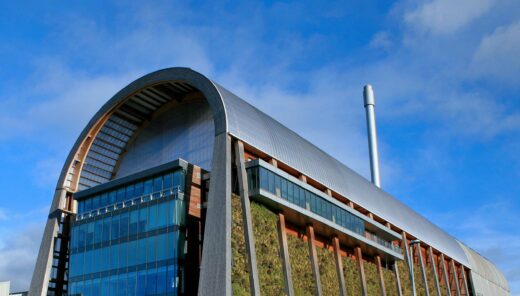Net zero carbon consultancy
With most people now living in urban areas – half of the world’s population in fact – the green transition will play an important role in both mitigating and adapting to a rapidly changing climate. To address this, governments, local authorities and businesses are developing net zero strategies to reduce their carbon emissions. But what does ‘net zero’ really mean and how does it apply to infrastructure design, organisational operations and city-scale planning?
The aim of any net zero vision should be to first reduce the source of greenhouse gas emissions as a priority, before then removing the rest of the residual emissions where possible. The term ‘net zero’ in this context can be applied at different scales, for example:
- Buildings and infrastructure – using sustainable materials in new builds, retrofitting existing buildings
- Businesses and organisations – by improving energy efficiency, using renewable energy technologies, encouraging sustainable behaviour change
- Cities and regions – by expanding active travel options, shifting to renewable energy, building low carbon infrastructure projects
Organisations are committing to specific timeframes in which to implement net zero actions and achieve net zero emissions, in line with various national (e.g., UK net zero target of 2045) and international climate commitments (e.g., Paris Agreement objectives) and the green transition as a whole. At Sweco, we can provide strategic net zero carbon consultancy as well as multi-disciplinary planning, design and engineering expertise to help set and support net zero ambitions in cities as the focal points of our economic, political, social activity and critical infrastructure.
‘Net zero’ simply means achieving a state where greenhouse gases that are emitted into the atmosphere by human activity (e.g., by burning coal or driving combustion engine vehicles) are balanced by removal out of the atmosphere (e.g., carbon sequestration technologies or tree planting).
The science clearly states that to avert the worst impacts of climate change, global temperature increase needs to be limited to 1.5°C above pre-industrial levels. The Earth is already at least 1.1°C warmer than what it was in the late 1800s and emissions will only continue to rise with rapid urbanisation and population growth. The need to drive decarbonisation within business, industry and society is unequivocal.
As we build new cities and communities, it is important we reduce embodied emissions through better design and new materials selection. We apply leading class design with our clients in our work in the built environment, transport systems and across our energy, water and waste infrastructure.
Gordon McGregor Chief Sustainability Officer, Sweco UK & Ireland
Achieving actual zero greenhouse gas emissions is not a realistic option. Instead, net zero emissions would mean that any emissions that could not be eliminated by 2050 would be compensated for by measures that remove emissions from the atmosphere. However, the priority is to develop societal behaviours across citizens and businesses, to be more sustainable, reduce consumption and be more resourceful, which will result in the reduction of emissions.
14 key considerations for a Net Zero City
Find out what our experts believe are the most important building blocks for carbon-conscious urbanisation.
Sustainability is not just about reducing emissions. It’s also about improving health and wellbeing. We’ve seen far more of a holistic picture since the COVID 19 pandemic. We’ve realised that, in a just transition, you have to enhance access to employment and transport systems. It’s about improving quality of life.
Dr Katherine Maxwell Technical Director – Net Zero Cities

5 steps to creating a net zero city strategy
We sat down with Net Zero Cities Technical Director Katherine Maxwell to get a snapshot of the steps needed to formulate – and follow – a clear and actionable net zero city strategy.
Elle Bartleet
Assistant Carbon ConsultantMonika Potomska
Senior Sustainability Consultant










